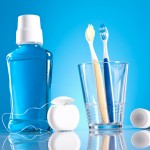
Gingivitis and periodontal disease are very common. Prevention is dependent on good control of the supragingival biofilm. Reviews have demonstrated the effectiveness of some anti-plaque agents but comparisons between products is more limited.
The aim of this review and network meta-analysis (NMA) was to compare the efficacy of different anti-plaque chemical agents, in 6-month, home-use, in terms of plaque index (PlI) changes.
Methods
A search was conducted in PubMed central database. Randomised controlled trials (RCTs) with at least 6 month follow up evaluating the use of test products used in mouthrinses, toothpastes or gels as adjuncts to mechanical oral hygiene (including toothbrushing) were considered.
Two reviewers selected studies, abstracted data and assessed risk of bias. The Cochrane Risk of bias tool was used Only plaque index (PII) scores were considered with outcomes being summarised as mean and standard deviation (SD) or standard error (SE), mean treatment effect (baseline-6 months) was calculated and results were pooled and analysed using weighted mean differences (WMD) and 95% confidence intervals (CI). Initially a pairwise meta-analysis was carried out followed by a network meta-analysis (NMA) based on a multivariate random effects meta-regression.
Results
- 89 RCTs were included, 49 examined dentifrices, 32 mouthrinses and 2 both.
- 63 RCTs contributed to the qualitative analysis which was carried out using the
- Turesky modification of the Quigley & Hein plaque index.
- The NMA analysed 51 studies including data from 4242 and 4180 subjects for dentifrices and mouthrinses respectively.
- For dentifrices, triclosan-copolymer and chlorhexidine showed the greatest effect, with significant differences when compared with stannous fluoride.
- For mouthrinses, essential oils and chlorhexidine showed the greatest effect, with significant differences when compared with delmopinol, alexidine and cetylpyridinium chloride.
Conclusions
The authors concluded: –
Within the limitations of this study (including the severe imbalance in the amount of evidence), dentifrices containing triclosan-copolymer or chlorhexidine and mouthrinses containing essential oils or chlorhexidine showed the greatest effect on PlI scores as assessed with NMA.
Comments
This review and network meta-analysis has restricted it search strategy to a single database and while a significant number of studies have been identified there is the possibility that relevant studies could have been excluded. As the PubMed database included the majority of the main dental journals there is the possibility of a selection bias as studies demonstrating little or no effect of these anti-plaque agents may have been published in non-Medline journals. For as the authors note all the active agents demonstrated a positive effect on plaque index. It should noted that the outcome considered in the review is a surrogate one and these findings only represent an impact in the relatively short term (6 months) and given that periodontal disease is a chronic disease it would be helpful to see if the benefits identified persist for longer.
Network meta-analysis are useful in that they permit the comparison of interventions that may or may not have been directly evaluated against each other. However they are complex and can be seen by the length of this paper and its additional supplements.
The positive effect of triclosan toothpaste on plaque that has previously been demonstrates in a Cochrane review (Dental Elf – 9th Dec 2013) and last week we noted a review highlighting the benefits of essential oils mouth washes (Dental Elf – 5th Oct 2016) and we have previously blogged about the impact of chlorhexidine mouthwash. (Dental Elf – 1st Aug 2014 & 1st May 2012).
Links
Primary paper
Escribano M, Figuero E, Martín C, Tobías A, Serrano J, Roldán S, Herrera D. Efficacy of adjunctive anti-plaque chemical agents: a systematic review and network meta-analyses of the Turesky modification of the Quigley and Hein plaque index. J Clin Periodontol. 2016 Aug 17. doi: 10.1111/jcpe.12616. Review. PubMed PMID: 27531174.
Other references
Dental Elf – 5th Oct 2016
Essential oils mouthwash reduced plaque and gingival inflammation
Dental Elf – 10th Apr 2015
Dental Elf – 1st Aug 2014
Dental Elf – 9th Dec 2013
Review shows that triclosan copolymer toothpaste reduced plaque, gingivitis and caries
Dental Elf – 1st May 2012
Evidence for the anti-plaque and anti-gingivitis effects of chlorhexidine

Anti-plaque agents: do they help reduce plaque levels? https://t.co/zFpGI48g8b
[…] post Anti-plaque agents: do they help reduce plaque levels? […]
Anti-plaque agents: do they help reduce plaque levels? https://t.co/3bIsKl8eic
Toothpaste with triclosan-copolymer or chlorhexidine has greatest effect on plaque indicies https://t.co/3bIsKl8eic
Do anti-plaque agents help reduce plaque levels? https://t.co/3bIsKl8eic
Mouthrinses with essential oils or chlorhexidine has greatest effect on plaque indicies https://t.co/3bIsKl8eic
Don’t miss- Anti-plaque agents: do they help reduce plaque levels? https://t.co/3bIsKl8eic
Anti-plaque agents: do they help reduce plaque levels? @TheDentalElf looks at the evidence https://t.co/u2bmbU63Ix
[…] Anti-plaque agents: do they help reduce plaque levels? […]
[…] Anti-plaque agents: do they help reduce plaque levels? […]